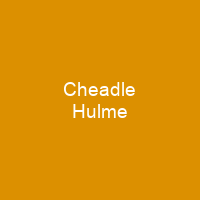Cheadle Hulme: A Village with a Rich History
Imagine stepping into a village where history whispers through every cobblestone and ancient building. Cheadle Hulme, nestled in the heart of Greater Manchester, is such a place. How many stories does this quaint village hold?
A Village Born from Ancient Times
Cheadle Hulme has been around for centuries, with evidence of Bronze Age, Roman, and Anglo-Saxon activity in the area. The Domesday Book mentions it as a large estate, hinting at its importance even back then. Can you imagine what life was like when Cheadle Hulme first appeared on the map?
The Evolution of Governance
Over time, Cheadle Hulme has seen many changes in governance. From being part of Cheshire to becoming a separate civil parish and eventually merging with other areas to form the Metropolitan Borough of Stockport, its journey is as fascinating as it is complex. How does this history shape the village today?
Natural Beauty and Climate
Cheadle Hulme sits in the Ladybrook Valley on the Cheshire Plain, surrounded by a landscape that has remained largely unchanged for centuries. The local geology is glacial boulder clay, creating a unique environment where ancient trees stand alongside modern developments. Doesn’t this blend of old and new make Cheadle Hulme even more intriguing?
Economic Growth and Diversity
The village’s economy has transformed over the years, from rural farming to bustling trade and industry. The introduction of railways brought new opportunities, leading to a population boom in the early 20th century. Today, Cheadle Hulme is home to a diverse mix of businesses, from retail shops to industrial estates. How has this economic diversity shaped the community?
Cultural and Religious Diversity
The village boasts a rich tapestry of cultural venues, including libraries, theatres, and chess clubs. Its religious landscape is equally diverse, with churches representing various denominations. Does this diversity make Cheadle Hulme a melting pot of cultures?
Sports and Leisure
Cheadle Hulme offers plenty for sports enthusiasts. From rugby to cricket, lacrosse to football, the village has something for everyone. Local teams like Cheadle Hulme Athletic and Cheadle Hulme Galaxy FC have gained recognition in recent years. Doesn’t this vibrant sporting culture add to the community’s spirit?
Notable People
Cheadle Hulme has produced its fair share of notable individuals, including actor Tim McInnerny. His roles in Blackadder have made him a household name, but his roots in Cheadle Hulme add an extra layer to his legacy. Who else might be hiding in the shadows of this village?
Governance and Population
Cheadle Hulme’s governance has undergone several changes, reflecting its growth over time. The village is now part of the Metropolitan Borough of Stockport, with a population density that reflects its urban character. How does this modern governance impact daily life in Cheadle Hulme?
Economy and Employment
The economy of Cheadle Hulme has evolved significantly over the years. From agriculture to retail, the village’s industries have shaped its character. The largest employers today are in wholesale and retail trade, with real estate and business activities following closely behind. How does this economic landscape influence the lives of residents?
Cultural Venues
Cheadle Hulme is home to various cultural venues that enrich the community’s life. From libraries to amateur theatre societies, these places provide a platform for creativity and learning. Do you think these venues play a crucial role in shaping the village’s identity?
Religious Affiliation
The religious landscape of Cheadle Hulme is diverse, with Christian, Muslim, Hindu, Jewish, Buddhist, and Sikh communities coexisting. This diversity adds to the rich tapestry of the village’s cultural fabric. How does this religious diversity contribute to the community’s unity?
Conclusion
Cheadle Hulme is a vibrant village with a rich history, diverse economy, and a thriving community. From its ancient origins to its modern-day developments, Cheadle Hulme continues to evolve while preserving its unique character. What makes this village so special?

You want to know more about Cheadle Hulme?
This page is based on the article Cheadle Hulme published in Wikipedia (retrieved on December 3, 2024) and was automatically summarized using artificial intelligence.







